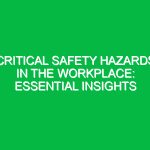Introduction
Safety in construction is a critical aspect of the Health, Safety, and Environment (HSE) domain, encompassing a broad range of practices and Regulations designed to protect workers and the environment from harm. The construction industry is inherently risky, with numerous Hazards present on site, including heavy machinery, heights, and hazardous materials. These risks make the implementation of robust Safety Measures essential. In this article, we will explore the significance of Safety in construction, discuss Best Practices, examine regulations, and provide actionable insights for creating a secure worksite.
Key Aspects of Safety in Construction
Understanding Risks and Hazards
In the construction industry, various hazards can lead to accidents, injuries, or even fatalities. Some of the most common risks include:
- Falls: Often cited as the leading cause of death in the construction sector, falls can occur from ladders, scaffolding, or roofs.
- Struck-by incidents: Workers can be injured by falling objects, machinery, or vehicles on site.
- Electrocution: Contact with live wires or faulty equipment poses significant risks.
- Hazardous materials: Exposure to chemicals, asbestos, or silica can lead to severe health issues.
- Equipment-related injuries: Improper use of tools or machinery can result in serious accidents.
Understanding these risks is the first step in developing effective safety protocols. For instance, in a real-life scenario at a construction site in Chicago, a worker fell from an unguarded scaffold, sustaining severe injuries. This incident prompted a reevaluation of Safety Measures and led to improved Training and the installation of guardrails.
Best Practices for Safety in Construction
Implementing Best Practices can significantly reduce the likelihood of accidents on construction sites. Here are some essential safety measures:
- Training and Awareness: Regular training sessions ensure that all workers are aware of potential hazards and understand proper safety Procedures.
- Personal Protective Equipment (PPE): Providing appropriate PPE, such as helmets, gloves, and harnesses, is crucial in mitigating risks.
- Site Inspections: Conducting daily inspections to identify and rectify hazards can prevent accidents before they occur.
- Emergency Preparedness: Establishing clear emergency response plans and conducting drills can prepare workers for unforeseen incidents.
- Communication: Encouraging open dialogue about safety concerns helps create a culture of safety among workers.
A notable example of effective training comes from a large construction firm that implemented a comprehensive safety program. This program included hands-on training, workshops, and regular safety meetings, resulting in a 40% reduction in workplace accidents over two years.
Creating a Safety Culture
Fostering a culture of safety is vital for reducing risks on construction sites. This culture begins with leadership commitment. When management prioritizes safety and sets a positive example, workers are more likely to follow suit. Here are some ways to promote a safety culture:
- Lead by Example: Leaders should actively participate in safety training and adhere to safety protocols.
- Recognize Safe Behavior: Acknowledge and reward employees who demonstrate Safe Practices, reinforcing the importance of safety.
- Encourage Reporting: Implement a non-punitive reporting system for near misses and unsafe conditions, allowing for continuous improvement.
An anecdote from a construction company in Texas illustrates the impact of a safety culture. After implementing a recognition program for safe work practices, the company saw a significant increase in employee engagement and a marked decrease in safety incidents.
Regulations and Standards in Safety in Construction
Compliance with regulations and standards is a fundamental aspect of safety in construction. Various organizations, including the Occupational Safety and Health Administration (OSHA) in the United States, set forth rules that govern safety practices in the industry. Some key regulations include:
- osha 29 CFR 1926: This standard outlines safety and health regulations for construction, providing guidelines on Fall Protection, scaffolding, and hazardous materials.
- ANSI/ISEA 105: This standard addresses the classification and performance of hand protection, ensuring workers have the appropriate gloves for their tasks.
- ISO 45001: An international standard for Occupational Health and safety management systems, it provides a framework for organizations to improve employee safety, reduce workplace risks, and create better working conditions.
Adhering to these regulations not only ensures worker safety but also protects companies from legal repercussions. For instance, a construction company that fails to comply with OSHA regulations could face hefty fines, not to mention the reputational damage from workplace accidents.
The Importance of Risk Assessment
Conducting thorough risk assessments is an integral part of ensuring safety in construction. A risk assessment involves identifying potential hazards, evaluating the risks associated with them, and implementing measures to control those risks. The process typically includes:
- Identifying Hazards: Walk the site and identify anything that could cause harm.
- Evaluating Risks: Assess the likelihood of each hazard occurring and the potential consequences.
- Implementing Controls: Develop strategies to eliminate or minimize risks, such as using safety barriers or providing training.
In a hypothetical scenario, if a construction manager identifies the risk of equipment tipping over, they might decide to implement additional training for operators and conduct regular Maintenance checks to ensure equipment stability.
Benefits of Prioritizing Safety in Construction
The advantages of prioritizing safety in construction extend beyond just compliance with regulations. Here are some key Benefits:
- Reduced Accidents: A focus on safety leads to fewer accidents and injuries, protecting the workforce.
- Increased Productivity: When workers feel safe, they are more focused and productive, leading to better project outcomes.
- Cost Savings: Fewer accidents translate to lower insurance premiums and reduced costs associated with worker compensation and legal fees.
- Enhanced Reputation: Companies known for their commitment to safety attract more clients and skilled workers.
For example, a construction firm that implemented a rigorous safety program not only reduced its accident rate but also saw an increase in client contracts due to its reputation for safety.
Conclusion
Safety in construction is not merely a regulatory requirement; it is a fundamental part of fostering a secure and productive work environment. By understanding the risks, implementing best practices, complying with regulations, and cultivating a safety culture, construction companies can significantly reduce hazards and enhance overall safety. The benefits of prioritizing safety are manifold, impacting not only the health and well-being of workers but also the financial performance and reputation of the organization.
As the construction industry continues to evolve, ongoing education and adaptation of safety practices will be essential in promoting health, safety, and environmental Sustainability. It is imperative for all stakeholders—workers, management, and regulators—to work together in fostering a culture where safety is paramount. The construction site of tomorrow should be one where every worker feels secure, empowered, and valued.


